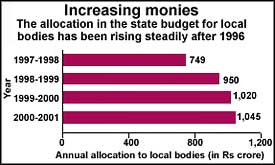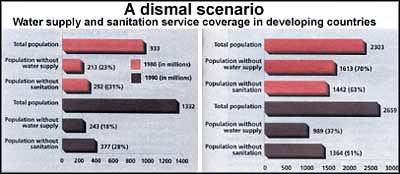
Drowning In Human Excreta
Sanitation for urban India means building flush toilets and linking them to sewer systems. But the price of chasing this dream is leading to an environmental catastrophe. MANOJ NADKARNI analyses our flush and forget mindset

Sanitation for urban India means building flush toilets and linking them to sewer systems. But the price of chasing this dream is leading to an environmental catastrophe. MANOJ NADKARNI analyses our flush and forget mindset

Port Blair, port city of the Andamans, is in a developmental cul de sac
ENVIRONMENTAL problems, like other real-world concerns, never make for soft solutions. Even on the eve of its implementation, the laudable scheme whereby all new cars registered in Delhi, Bombay,
Rainfed regions are those where crop production is exclusively dependent upon rainfall. In India they cover 177 districts and exist in all agro-climatic regions but are mostly concentrated in the

Decentralisation in Kerala is the work of a persistent civil society

Coping with the nuisanceof urban monkeys may be beyond human patience. But shooting or declaring them pests will not serve the problem. Only a rational conservation programme can help save monkeys and keep our age old veneration for them inact
health is not only - or even primarily - the concern of doctors and nurses. The community has a major role to play in creating an environment that makes available better health care facilities and

Water. A resource whose scarcity and inefficient allocation gives enough cause for concern. A concern which could find a solution in the concept of market-based allocation and tradeable water rights
FOR some time now, international funding agencies have been at pains to show that they are concerned about the environmental and social aspects of the policies they promote. Very often, such concern

It is important to generate a national debate on the Biological Diversity Bill

Every day, the country's numerous hospitals and medical facilities churn out millions of tonnes of waste. An alarming percentage of this waste lies in the open, like festering sores on civilisation's body, as breeding grounds of lethal virulences and

So dependent are the Bhils on trees, deforestation is eroding the very roots of their culture

The Oriya name for the saltwater crocodile (Crocodylus porosus) is baula kumbhira, which literally means crazy crocodile. The moniker certainly rings true for people living in about 50 villages

No profit motives, no glamour, just dedicated nature lovers with bins at the ready: SNF is a highly politicised organisation
<font class='UCASE'>John Whitelegg</font> of the School of Built Environment at Liverpool s John Moores University spoke to <font class='UCASE'>Anish Gupta </font> about Calcutta s transport problems and about why its salvation lies in improving the tra

Eco friendly clothes look cool on the ramp model, but how long will they stay in vogue?
<p>Somebody recently asked me why India supported the Copenhagen Accord. It is correct to say that the proposed accord has no meaningful targets for emission reduction from Annex 1 (industrialized countries). Global emissions will increase or reduce at best marginally. So it will be bad for the world’s efforts to combat climate change. We are victims of climate change.

A United Nations conference reveals the sense of desperate urgency concerning the oceans' rapidly depleting fish stocks

The fisheries department sets new rules for acquafarmers to avoid the recurrence of a viral devastation
R&D is a fast evolving segment of Indian pharmaceutical industry. Innovation, international partnerships, collaborations, inflow of funds, clinical trials partnerships and co-development deals are changing the landscape of R&D. However, the potential is far greater and to aid the harnessing of this potential, the Times Group organised the ET Bio-Pharma Development Summit in Mumbai. Dr Swati Piramal, director, Nicholas Piramal, was the chairperson of the forum, with the keynote speaker being Dr Ted Bianco, director, Wellcome Trust. The highlight of the event was the special address delivered by Kapil Sibal, union minister for science and technology and earth sciences. Dr Piramal delivered the opening address to a house full of delegates. She highlighted the need of innovation in R&D and how India can excel in the same. Her address was followed by an interesting speech made by Dr Ted Bianco, director, Wellcome Trust, UK. He provided an insight into early stage R&D through translational research funding and management of intellectual property arising thereafter. Then, it was time for Mr Sibal's speech. He termed the new disease pathogens the terrorists of the 21st century and said there was an urgent need to safeguard public health. He also made a strong case for growth of R&D in case of Indian pharmaceutical industry and how it could be harnessed in India to provide affordable cure. The minister stressed on the need for a forward-looking drug policy and government subsidies to boost innovation in the country. Malvinder Singh, MD and CEO, Ranbaxy Laboratories, the speaker for the second session, gave a address on the future of generics. He informed that the global bio-generic industry was worth $60 billion today. Indian pharma industry can capitalize on this opportunity and grow to become $100 billion industry in the coming years. He pointed out that having 50 NCEs being produced by 15-20 companies is not economically sustainable. Industry needn't duplicate infrastructure as it would be feasible to unite through partnerships and collaborations, he said. He also stressed upon the need for an enabling regulatory framework, which moves away from the price control regime. He pointed out that at present, R&D done internally by the companies alone qualified for weighted deduction under section 35(2AB) of Income tax act. He urged that the government to facilitate innovation by extending this benefit to outsourced R&D as well. The third session was a panel discussion providing an HR perspective on strategies for human resource management. Dr Ganesh Shermon, partner & country head, human capital advisory services, KPMG India, Rajorshi Ganguli, director, HR, Dr Reddy's Laboratories, Sanjay Muthal, president, HR, Nicholas Piramal and Shiv Raman Dugal, chairman, Instiute of Clinical Research of India, were the distinguished speakers forming the panel. Various strategies needed to drive excellence in research and cross-functional areas were discussed. The next session emphasising on what's next in Indian bio-pharmaceuticals was moderated by Utkarsh Palnitkar, national head of health and science industry, Ernst & Young, India. One of the speakers - Dr Ramani Aiyer, chief scientific officer, Actis Biologics - highlighted the new trends in bio pharma. He also delved into the concepts of angiogenesis, gene therapy, recombinant proteins and follow-on biologics. Kavita Khanna, president, Bharat serums & Vaccines, was the next speaker in the session and gave her views on the way forward in publicprivate partnerships. She presented a case study on 'Kala Azaar' (Leishmaniasis), to explain how public private partnership was being proposed to eradicate the disease by 2010. Adnan Naseemullah, a student of university of California, Berkeley, was one of the invitees to the session. He spoke about the growth and development of the Indian pharmaceutical industry and highlighted the variations in research strategies followed by the industry. The post lunch session was a two-speaker special session held by Dr S K Gupta, dean and director, Institute of Clinical Research of India (ICRI) and Dr Anand Bidarkar, VP, Siro Clinpharm India. They delved into the various clinical research strategies to maange research and development in India. Dr Gupta provided the statistical data on the infrastructure which is available for clinical research in India and how can India emerge as a world-class destination for conducting quality clinical research. Dr Bidarkar explained how MNCs were taking advantage of Indian clinical R&D to shorten their drug development timelines. He also highlighted how Indian companies could look at outsourcing to overcome their competitive disadvantages. The concluding session of the day was the CEO round table. Presided by Dr Piramal, with Pratibha Pilgaonkar, CEO, Rubicon Research, Dr Naveen Rao, MD, Merck India and Dr Ajit Dangi, president and CEO, Danssen Consulting, being the other participants in the discussion. Dr Piramal posed various questions to the panel relating to scope of R&D in India, possibility of doing a Nano in pharma and cost of innovation. Dr Naveen Rao, MD, Merck India, expressed the need for big pharma companies to look at India and its cost-effective resources. He also stated that partnerships offered an attractive method of risk and reward sharing. Ms Pilgaonkar pointed out that SMEs in Indian pharma industry at an early stage need the support and funding from big players in the industry to become agents of research and innovation. Dr Dangi stressed on the need for world class intellectual property (IPR) regime, lowering of transaction costs and a liberal price policy in the country. Strengthening of the infrastructure of Drug Controller General of India, approval of various protocols for clinical trials, framing of laws on cloning and neutraceuticals were other issues discussed by the panel discussion. Dr Piramal projected that by 2010, India would have discovered at least five new drugs . Her personal bet on the cost of innovation of a new drug in India stood at less than $50 million. The session concluded after a question and answer session where the audience put forth their questions to the panelists.